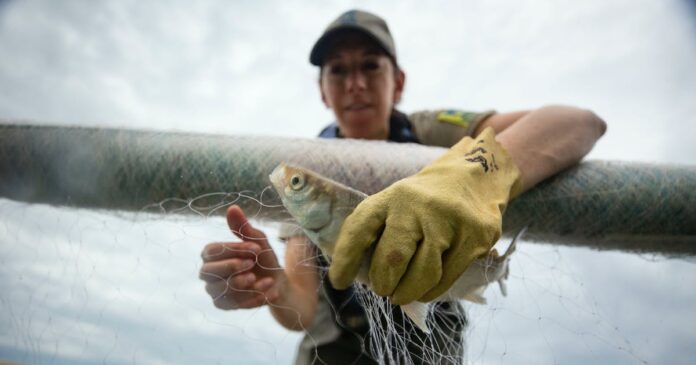A small, crucial fish that lives in the cold, deep waters of Lake Superior just had one of its healthiest years in at least four decades.
Potentially record numbers of lake herring — also called cisco — born last spring seem to have survived their first year of life, according to state and federal biologists. At a year old, they should be just large enough that few predators in Lake Superior will now eat them.
The stunning boom, not seen since at least 1984, will help sustain both the ecosystem and Minnesota’s commercial fishing industry in one of the world’s greatest lakes for years to come, said Cory Goldsworthy, Lake Superior fisheries supervisor for the Minnesota Department of Natural Resources.
“This is what we’ve been waiting for,” Goldsworthy said. “It’s something we’ve never seen before in our careers and may not see again.”
Superior’s herring are prized by commercial fishermen for their fillets and eggs, which can be made into a caviar. They are key prey of lake trout, walleye and other popular game and predator fish. Healthy herring populations can lead to fatter, healthier trout and walleye, Goldsworthy said.
It still may be a couple of years before the year-old herring show up in gill nets and on the tables of restaurants throughout the North Shore.
Much can happen between now and then, said Eric Brisson, co-owner of North Superior Fishery out of Grand Marais.
“Herring are always hit or miss,” he said. “It’s a big lake out there, so you never can tell.”
Demand for locally caught fish is as high as it’s ever been, said Stephen Dahl, 71, who has fished for herring out of the Duluth area for about 35 years.
“It’s real good to hear,” he said of the high numbers. “The local food thing is so strong I can’t keep up with the market. There isn’t enough of me.”
Herring had been over-fished throughout much of the 20th century, and their numbers plummeted. Conservation efforts and fishing limits helped bring them back starting in the 1970s.
Herring populations can boom and bust, as they need temperatures and conditions to be just right to successfully hatch their eggs. The water needs to be icy cold, yet still full of the zooplankton that young herring need to grow, Goldsworthy said.
If they can make it a year, they have a strong likelihood of surviving to maturity, he said.
A herring can live up to 40 years in Lake Superior. They evolved alongside lake trout — their top predator — and put all their energy during their first few years into growing. Once they reach about 14 inches — a length where only Superior’s very biggest lake trout are still able to fit them in their mouths — the herring almost flip a switch and stop growing. They instead put their energy into reproduction.
Biologists and anglers suspected that herring were having a great year as early as November, seeing strong signs of their growth inside the bellies of lake trout. They waited for an annual survey conducted each spring by the United States Geological Survey (USGS) to confirm their hopes.
The lake’s best year on record for herring is 1984, when USGS researchers estimated that there were 748 young herring per hectare — Lake Superior is more than 8 million hectares.
There hasn’t been a strong year since 2003, when an estimated 175 per hectare made it to a year old. Since then, numbers have been dismal. In the worst year on record — 2013 — USGS estimated that almost no fish born that year survived.
After 20 years of poor survival rates, it seemed like Superior could no longer support high numbers of herring. The lake is freezing less often as the climate changes, and spring and fall storms have become more intense. Invasive species have upended parts of the food chain.
But the lake water turned cold enough, with abundant zooplankton, in early 2022.
A USGS research vessel has been systemically trawling the bottom of the lake this spring. The annual survey will wrap up on Monday and a final peer-reviewed population estimate won’t be ready for some time, said Dan Yule, a biologist with USGS.
But enough herring have already been pulled up to know that this year is special, he said.



